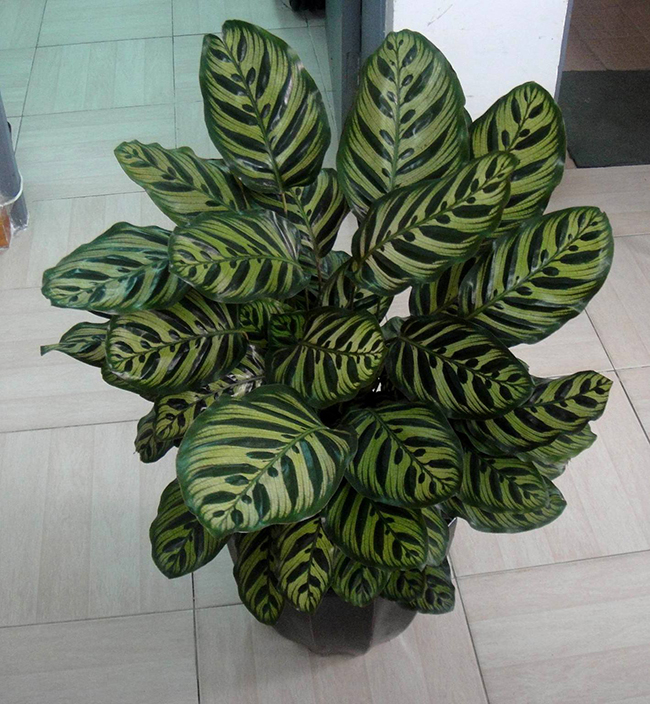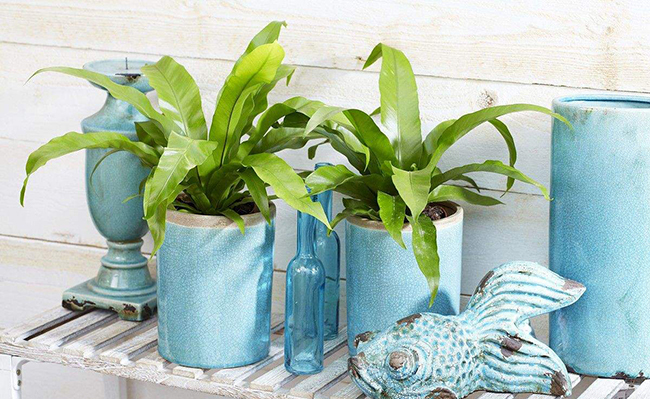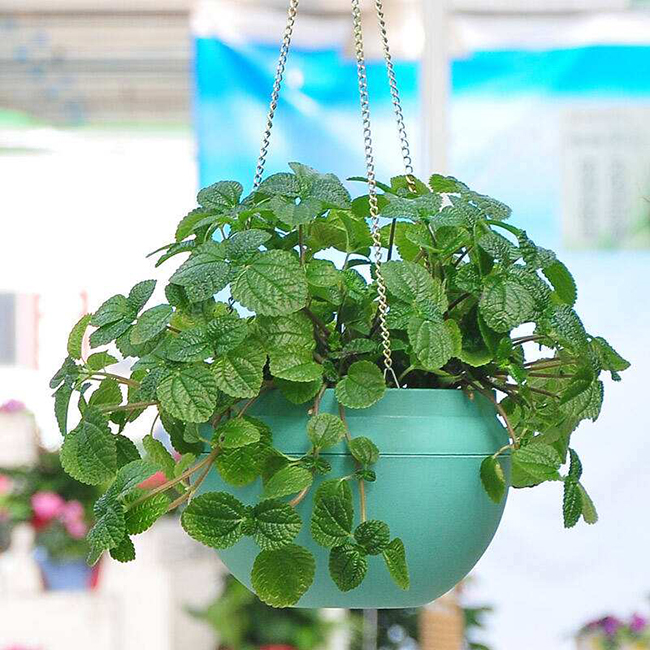Culture methods and matters needing attention of Peacock Bamboo Taro
Introduction of Peacock Bamboo Taro
Peacock taro: bamboo taro family, Xiao bamboo taro belongs to perennial evergreen herbs. The height of the plant can be up to 60 cm. Petiole purplish red, leaf blade thin leathery, ovate-oval, with dark green and white or yellowish feather markings on the leaf surface, just like the pattern on the peacock tail feathers, hence the name. The leaves also have characteristics: they stretch during the day and fold up at night.

Growth habits of peacock bamboo taro
Like semi-overcast, not resistant to direct sunlight, adapt to grow in a warm, humid environment. The cultivation should be shaded to a certain extent, and the temperature should be kept at about 12-29 ℃, and the winter temperature should be maintained at 16-18 ℃. The growth is exuberant in spring and summer, which requires higher air humidity and can be sprayed. The soil is not very strict, but it is required to keep moderately moist. In the growing season, fertilizer is applied once every two weeks, while the soil can be slightly dry and cool in winter, and the number of fertilization can be reduced.
Propagation method of Peacock Bamboo Taro
Ramet propagation is generally used when the daily temperature is about 20 ℃ in early summer every year (the air temperature is too low, ramets are easy to hurt roots, affecting survival or weakening growth). After digging out the old plants with dense growth, split along the underground rhizome, leaving 2-3 lingering buds in each section, put it in the basin immediately after cutting, put it in a cool place for a week, and then gradually move to a place with sufficient light. The moisture should be controlled at the initial stage of ramet planting, and the new roots should be fully watered.
Ramet propagation
It can be operated in combination with turning basin and changing soil from March to April in spring. The number of ramets at a time should not be too large, otherwise the growth of the plant should be affected, depending on the size and growth of the mother plant.
Cuttage propagation
In summer, young branches with 2 to 3 leaves at the base are selected as cuttings, or some kinds of creeping wood cuttings are used. It can be mixed with peat soil and river sand, or vermiculite and perlite can be used as substrates to keep it moist. It can take root in about 5 weeks and be planted in pots.
Culture method of Peacock Bamboo Taro
Soil selection
Pot cultivation of peacock bamboo taro should use loose, fertile, well-drained, humus-rich slightly acidic loam, generally can be mixed with 3 parts of rotten leaf soil, 1 part of peat or sawdust, 1 part of sand, and add a small amount of bean cake as base fertilizer, avoid heavy and sticky garden soil. When putting on the basin, the bottom of the basin is padded with 3 cm thick coarse sand as a drainage layer to facilitate drainage.
Water demand
Adequate moisture should be given during the growing period, especially in summer and autumn, in addition to keeping the basin soil moist, it is also necessary to spray water to the leaves to cool and moisturize; it requires a higher air humidity, preferably up to 70% to 80%; avoid dry air and dry basin soil, but do not accumulate water. Moisture should be controlled after the end of autumn in order to resist cold and survive the winter. Keep the dry environment in winter, if it is too wet, the basal leaves will be yellow and scorched, which will affect its ornamental value.
Lighting requirement
From May to September, the growing season should be placed in a shady or semi-shady place to maintain a light transmittance of 40% and 60%, so as to avoid direct sunlight. Excessive light or dry air can easily lead to scorched leaf tips and dull leaf markings; but the light should not be too weak. If placed in a dark room for a long time, the temperature is low and the light is insufficient, it will also grow weak, not conducive to the formation of leaf color and lose the unique metallic luster of the leaf. Direct sunlight through glass is acceptable in winter.
Fertilization requirements
When the peacock bamboo taro is short of fertilizer, the plant is obviously short, the leaf color is dim, and the golden luster is not bright. Applying dilute liquid fertilizer every 20 days during the growing period, the ratio of nitrogen, phosphorus and potassium should be 2 ∶ 1 ∶ 1, which can make the leaves glossy and bright, and the proportion of nitrogen fertilizer should not be too large. If 0.2% liquid fertilizer is directly sprayed on the leaf surface every 10 days, it is extremely beneficial to sprouting and growth, and stop spinning fertilizer in winter and summer.
Pest control
Peacock bamboo taro has less diseases and insect pests, but under the condition of dry air and poor ventilation, it is easy to grow shell insects, whitefly and so on, which can be sprayed with 25% thiocarbophos emulsion 1000 times or 40% omethoate 1500 times.
Matters needing attention in peacock bamboo taro culture
The root of peacock bamboo taro is shallow, so it is appropriate to choose a large mouth and shallow basin, so that the growth of the root is not affected, and the leaves are not spread out during the day. The basin soil is loose, permeable, well drained and slightly acidic with rich nutrition.
Generally speaking, the pots of peacock taro are changed in spring, and the pots are changed every 1-2 years. When changing pots, new culture soil should be added, and the residual roots and leaves should be cut off and replanted to facilitate growth.
There are few diseases and insect pests in peacock bamboo taro, but if the ventilation is poor and the air is dry, shell insects will also occur. A series of imidacloprid drugs are used to control them. The main value of peacock bamboo taro
Taro has underground rhizome or tuber, and its leaves are solitary and large. In addition to the open leaf sheath at the base of the leaf, there is also a significantly expanded joint at the connection between the leaf and the petiole, called "leaf pillow", in which there are water storage cells, which can regulate the direction of the leaf, that is, the leaf is erect when there is sufficient water at night and when there is not enough water in the daytime. The leaf unfolds, which is a characteristic of the family Taro. In addition, some taros also have "sleep exercise", that is, the leaves spread out during the day and fold at night, which is very strange.
How to raise peacocks and taros? Culture methods and matters needing attention of Peacock Bamboo Taro
Peacock taro is a perennial evergreen herb, feathered leaves are like peacock blooming feathers, very beautiful, but also have a feature: stretch during the day, fold at night, then, how to raise peacock taro? The following is to introduce the peacock bamboo taro culture methods and matters needing attention.
The best propagation time of peacock taro: Peacock taro is mostly propagated by individual plants, which is usually carried out in combination with basin change and soil change from April to May in spring. The ramet is too early, the temperature is too low, the wound heals slowly, it is easy to cause rot and reduce the survival rate.
The main points of propagation of peacock bamboo taro: Peacock bamboo taro is mostly propagated by individual plants, which is combined with basin change and soil change from April to May in spring. The ramet is too early, the temperature is too low, the wound heals slowly, it is easy to cause rot and reduce the survival rate. When ramet, deduct the mother plant from the basin, remove the persistent soil, use a sharp knife to cut into 1 plant every 3 to 4 buds, apply charcoal powder to prevent corrosion, immediately put on the basin after cutting, pour water thoroughly, slow down the seedlings in the semi-shaded place, and transfer to normal management after 5 days. When dividing plants, it is better to plant 3-5 plants in one pot. If only one plant is planted in each pot, it is necessary to retain more than 5 leaves and bring more roots, otherwise it will affect the survival and growth and development of the plant.
The best growth soil of peacock bamboo taro: the pot culture of peacock bamboo taro should use loose, fertile, well drained, humus-rich slightly acidic loam, generally can be mixed with 3 parts of rotten leaf soil, 1 part of peat or sawdust and 1 part of sand, and add a small amount of bean cake as base fertilizer, avoid heavy and sticky garden soil. When putting on the basin, the bottom of the basin is padded with 3 cm thick coarse sand as a drainage layer to facilitate drainage.
Peacock taro growth humidity requirements: the suitable air humidity of peacock taro is 70%-75%, and the humidity requirement is higher when sending new leaves, so the growing season should be fully watered to keep the soil moist, but not stagnant water. Spray water on the leaves for 2 or 3 times a day in summer, and sprinkle water on the surrounding ground to humidify and cool down to facilitate its growth. Watering should be controlled in winter, and the basin soil can be slightly wet. The indoor air in northern winter is dry, except that the foliage can be sprayed with water similar to room temperature around noon during the day, it is best to put on a plastic film cover to keep warm and moisturizing at night. In order to keep the leaves fresh and tidy and shining, gently scrub the leaves with clean water every half a month.
The best growth temperature of peacock taro: peacock taro is not resistant to cold. The room temperature should not be lower than 15 ℃ when overwintering. The suitable temperature for the growth of peacock bamboo taro is 18-25 ℃. The summer temperature should not be higher than 35 ℃, otherwise the plant will stop growing and the leaf color will turn yellow. No less than 5 ℃ in winter to prevent frost injury.
The best growth light of peacock bamboo taro: peacock bamboo taro likes high temperature and humid environment, strong negative resistance, and the illumination is 30% to 40%.
Pay attention to watering peacock bamboo taro: in summer, you need to spray water on the leaf surface for 2 or 3 times a day, and sprinkle water to the surrounding ground to humidify and cool down to facilitate its growth. Watering should be controlled in winter and the basin soil can be slightly wet. The indoor air in northern winter is dry, except that the foliage can be sprayed with water similar to room temperature around noon during the day, it is best to put on a plastic film cover to keep warm and moisturizing at night. Those who have the conditions can use humidifiers to improve indoor humidity. In order to keep the leaf color fresh and tidy, shining, you should also gently scrub the leaves with clean water every half a month or so.
Fertilizer application of peacock taro: Peacock taro is applied with dilute liquid fertilizer about every half a month in the peak growing season. Attention should be paid not to apply too much nitrogen fertilizer, otherwise there will be poor growth phenomena such as leaf speckle fading, leaf thickening, petiole softness and so on. The ratio of nitrogen, phosphorus and potassium should be 1 ∶ 1 ∶ 1, which can make the leaves beautiful in color and luster.
Peacock taro pot soil replacement: Peacock taro generally change pots in spring, once every 1-2 years, new culture soil must be added when changing pots, and residual roots and leaves should be cut off and replanted to facilitate growth.
Peacock bamboo taro disease and insect control: peacock bamboo taro diseases and insect pests are less, but if the ventilation is poor, the air is dry, shell insects will also occur, imidacloprid series of drugs are used to spray and control.
Culture methods and matters needing attention of Peacock Bamboo Taro
I. cultivation
1. Knock the mother plant out of the basin and remove the old soil.
2. Cut the plant apart with a sharp knife so that each plant has 3-4 buds and 5-7 leaves.
3. After slicing, apply charcoal powder on the cut to avoid incision decay.
4. then plant the seed plant in a pot and pour enough water, first put it in a semi-shaded place for maintenance, so that it can gradually restore its growth, and after about 5-7 days, it can be moved to a place with good light for normal care.
Novice tip: before putting on the pot, you should pad about 3 centimeters of coarse sand at the bottom of the flowerpot as a drainage layer to facilitate smooth drainage.
Second, watering
1. It is necessary to supply enough water for the plant in the growing season, especially when the climate is dry in summer, in addition to watering the basin soil every day to keep the soil humid, it is also necessary to spray clear water on the leaf surface 2 or 3 times a day to reduce the temperature and maintain a certain humidity. Promote plant growth and development.
2. After entering the winter, we should pay attention to control watering, so that the basin soil is not dry, so that it can pass the winter, and wait until the next spring to produce new leaves and then water normally.
Third, lighting
Peacock bamboo taro is more able to tolerate shade, afraid of strong direct sunlight, and can be cooked for a long time where there is enough scattered light in the room.
4. Temperature
The suitable temperature for the growth of peacock bamboo taro is 18 ℃ ~ 25 ℃.
5. Fertilization
On weekdays, 0.2% liquid fertilizer can be sprayed directly on the leaf surface every 10 days. In the growing season, liquid fertilizer with lower concentration should be applied once a month. When fertilizing, we should mainly apply phosphate fertilizer and potassium fertilizer, not too much nitrogen fertilizer.
VI. Disease and pest control
1. The common disease of peacock taro is leaf spot. As soon as it is found, it is necessary to get rid of all the diseased leaves and weeds to prevent the disease from spreading, and use 50% mancozeb wettable powder 500 to 600 times.
2. When the peacock taro is harmed by shell insects, whitefly and so on, it can be effectively treated by spraying with 1000 times of 25% imidathion EC or 40% omethoate EC.
7. Pruning
When changing flowerpots every year, dry roots and withered leaves should be clipped to speed up plant growth and maintain beautiful shape.
- Prev

Breeding methods and matters needing attention of bird nest fern
Bird's nest fern growth habits bird's nest ferns often grow on tree trunks or rocks in rainforests or seasonal rain forests, like high temperature and humidity, but are not resistant to bright light. 1. Temperature: the suitable temperature for its growth is 16 ℃ to 27 ℃, of which 22 ℃ to 27 ℃ from March to October
- Next

Culture methods and matters needing attention of drug-addicted weeds
Morphological characteristics of drug addicts, plant height 50 cm, stems and leaves with soapy fragrance, wheel umbels, lip-shaped lavender flowers, florescence from July to August. Heat-resistant and cold-resistant, drought-resistant, waterlogging-resistant and pruning-resistant. The Beginning of Winter pruned once before, can survive the winter safely. Drug addict grass is a kind of plant that is very hardy.
Related
- Fuxing push coffee new agricultural production and marketing class: lack of small-scale processing plants
- Jujube rice field leisure farm deep ploughing Yilan for five years to create a space for organic food and play
- Nongyu Farm-A trial of organic papaya for brave women with advanced technology
- Four points for attention in the prevention and control of diseases and insect pests of edible fungi
- How to add nutrient solution to Edible Fungi
- Is there any good way to control edible fungus mites?
- Open Inoculation Technology of Edible Fungi
- Is there any clever way to use fertilizer for edible fungus in winter?
- What agents are used to kill the pathogens of edible fungi in the mushroom shed?
- Rapid drying of Edible Fungi

